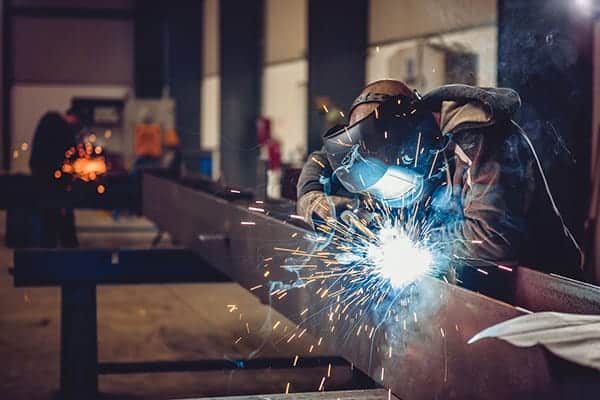Professional Welding Inspection Service for Safety Compliance
Professional Welding Inspection Service for Safety Compliance
Blog Article
Recognizing the Various Kinds Of Welding Techniques and Services Offered

Overview of Welding Techniques
Welding techniques include a diverse array of approaches utilized to sign up with products together completely. One usual method is arc welding, which entails creating an electric arc in between an electrode and the base material to melt and fuse them together. This method is functional and can be used with numerous metals, making it among the most commonly used welding processes.

Additionally, TIG welding, or Gas Tungsten Arc Welding (GTAW), is a accurate and clean welding method that utilizes a non-consumable tungsten electrode to produce the weld. TIG welding is generally made use of for thinner products and supplies exceptional control over the welding process. Generally, recognizing these various welding strategies is crucial for picking the most ideal approach for various jobs.
Typically Used Welding Methods
A range of frequently utilized techniques are utilized in the field of welding to effectively join materials together. One of one of the most widely utilized techniques is Gas Metal Arc Welding (GMAW), also recognized as MIG welding. This method utilizes a cord electrode that is fed through a welding weapon, together with a shielding gas to safeguard the weld from impurities in the air. Another usual technique is Secured Metal Arc Welding (SMAW), or stick welding, which utilizes a flux-coated electrode to develop the weld. Tungsten Inert Gas (TIG) welding is favored for its accuracy and versatility, using a non-consumable tungsten electrode to create the weld. Flux-Cored Arc Welding (FCAW) is generally utilized in commercial setups as a result of its high welding speed and mobility. Furthermore, Immersed Arc Welding (SAW) is optimal for developing deep welds on thick materials. These generally made use of welding techniques deal with different needs and materials, offering choices for numerous welding applications.
Advanced Welding Solutions
Structure upon the structure of typically made use of welding methods, the world of advanced welding services incorporates sophisticated strategies and modern technologies that press the limits of accuracy and effectiveness in material joining procedures. Advanced welding solutions frequently include specialized approaches such as laser welding, electron beam of light welding, and friction mix welding. Laser welding uses a very concentrated beam to precisely sign up with steels with very little heat-affected areas, making it excellent for complicated or fragile parts. Electron beam of light welding, on the various other hand, utilizes a high-velocity electron beam of light to produce deep weld infiltrations in materials like aerospace alloys or dissimilar steels. Friction mix welding, a solid-state joining procedure, enables the welding of products that are testing to fuse making use of traditional techniques, like light weight aluminum and copper. These innovative strategies use improved control over the welding process, leading to stronger, more durable welds with lowered distortion and improved total top quality.
Specialized Welding Methods

An additional specialized welding strategy is laser beam of light welding, where a very focused light beam of light is used to sign up with steels with minimal heat-affected areas and distortion. These specialized welding techniques showcase the variety and development present in the area of welding, providing options for a wide range of commercial applications.

Selecting the Right Welding Process
With various welding strategies readily available, it is vital to consider variables such as the type of steel, density, joint layout, and preferred end result when choosing the appropriate welding process. Among the usual welding techniques are Gas Metal Arc Welding (GMAW), Secured Steel Arc Welding (SMAW), Gas Tungsten Arc Welding (GTAW), and Flux-Cored Arc Welding (FCAW) GMAW, also understood as MIG welding, is suitable for welding slim to thick steels and is functional in various settings.
Verdict
To conclude, comprehending the various sorts of welding techniques and services available is essential for picking the right technique recommended you read for a specific project. By understanding the commonly utilized welding approaches, advanced welding solutions, and specialized techniques, people can make enlightened decisions to make sure the success of their welding jobs. It is essential to think about variables such as materials, job demands, and budget when selecting one of the most suitable welding process.
From standard techniques like stick welding to innovative procedures such as laser welding, the globe of welding offers a wide range of alternatives for joining steels together.Furthermore, TIG welding, or Gas Tungsten Arc Welding (GTAW), is a clean and precise welding technique that makes use of a non-consumable tungsten electrode to create the weld. Advanced welding services usually include specialized approaches such as laser welding, electron beam welding, and friction stir welding. Among the typical welding approaches are Gas Metal Arc Welding (GMAW), Secured Steel Arc Welding (SMAW), Gas Tungsten Arc Welding (GTAW), and Flux-Cored Arc Welding (FCAW) By being conscious of the typically utilized welding techniques, advanced welding solutions, and specialized strategies, people can make enlightened choices to ensure the success of their welding projects.
Report this page